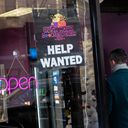America's labor shortage is bigger than the pandemic

The shortage of workers in the U.S. has become a flywheel of doom, messing up our lives and society writ large. And many of the underlying problems that led to this breakdown are bigger than the pandemic.
The big picture: Millions of immigrants, older workers and mothers are missing from the labor force. Those labor shortages create problems like supply chain woes, school closures, and skyrocketing child care costs — and some of those problems further exacerbate the worker shortages.
- U.S. CEOs say labor shortages are the top threat to their businesses this year, in a survey released by the Conference Board yesterday.
State of play: The labor market problems are broadly about COVID, but with root causes that predate the pandemic:
Lost immigrants: There are about 2 million fewer working-age immigrants in the U.S. because of Covid immigration restrictions, according to calculations of census data from two economists at University of California, Davis.
- About 1 million are higher-educated working age adults.
- The immigration slow down began during the Trump administration.
The Great Retirement: Covid spiked retirement rates. Flush with cash from the booming stock market and fearful for their health in a pandemic, many more older workers left the workforce.
- There are 3.3 million more retirees as of October 2021, than January 2020 (aka the before time), according to estimates from economists at the St. Louis Fed. The number exceeded pre-pandemic demographic expectations.
Beleaguered moms: About 1.5 million fewer mothers of school-age kids are actively working compared with pre-pandemic times, according to Misty L. Heggeness, a principal economist at the Census Bureau.
- Lack of social policy support for parents, particularly mothers — a key issue during the pandemic — has long depressed labor force participation rates for women in the U.S.
What's next: Economists are hopeful that when it becomes safer to return to work, more Americans will in fact go to work.
- "The most obvious solutions are public health solutions," says Aaron Sojourner, a labor economist at he University of Minnesota's Carlson School of Management. If people are healthy, and risks are low they'll be more willing to get back to work. "It's a win win."
But, but, but: Unless there is policy intervention, there will still be a shortage of immigrant workers, which holds back other parts of the economy.
- "We have lost two years of immigration and there is nothing in our system that allows us to catchup," says Giovanni Peri, an economist at University of California, Davis, who calculated the 2 million number with a colleague.
- Immigrants workers could help alleviate shortages in a range of industries, including child care.
- More child care workers would have downstream effect on working mothers and older women, who've stepped out of work to help with grandchildren's child care.